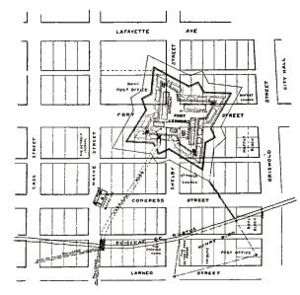
Fort Pontchartrain du Détroit or Fort Détroit was a fort established by the French officer Antoine de la Mothe Cadillac in 1701. The location of the former fort is now in the city of Detroit in the U.S. state of Michigan, an area bounded by Larned Street, Griswold Street, and the Civic Center.

Fort Detroit
French explorer and soldier Antoine Laumet de la Mothe Cadillac originally built Fort Detroit in 1701, naming it Fort Pontchartrain. The French hoped to use the fort to build alliances with the Indians living in the Ohio valley in order to protect their interests in the region from British encroachment. The fort was built along the Detroit River at the gateway between Lake Erie and the western Great Lakes. It consisted of a small town surrounded by a stockade wall. Fort Detroit soon became a center of the fur trade between the French and local Indians.
Antoine de laMothe Cadillac
The French surrendered the fort to the British in 1760 as a result of the French and Indian War. At this point the British named it Fort Detroit. The British reinforced the defenses around Detroit, making it even stronger. Indians attacked Fort Detroit during Pontiac's Rebellion in 1763, but they were not able to overcome its strong fortifications in spite of a five-month siege.
During the American Revolution, the British used Fort Detroit as a base to plan and launch Indian raids into the Ohio Country. Henry Hamilton, a man known for his policy of paying Indian allies for American scalps, was the fort's commander during the Revolution. In spite of the Treaty of Paris (1783), the British continued to occupy Fort Detroit even after the end of the war and encouraged growing tensions between the natives and American settlers.
The Americans eventually took over the fort in 1796. While Fort Detroit was under the control of General William Hull, the British briefly captured it once again during the War of 1812. Today, the modern city of Detroit, Michigan, is located where the fort once stood (source:http://missar.org/rev_war_sites/fort_detroit.html )

Chief Pontiac
The Ottawa chief Pontiac was born around 1720 near present-day Detroit, and although his early history is sketchy, he became a well-known warrior for his activities during the French and Indian War. Pontiac allied with New France in a losing bid to stop incursion by British colonists into the Great Lakes region. After the war, Pontiac became upset with new British trading policies. The chief met with leaders from several other regional tribes to form an organized resistance against the British. The resulting uprising, known as Pontiac’s Rebellion, or Pontiac’s War, began as Pontiac led an attack on Fort Detroit in May 1763. Emboldened by the attack, other warriors destroyed eight other forts from Michigan to western Pennsylvania, killing hundreds of British. Although unsuccessful in taking Fort Detroit, Pontiac’s warriors laid siege for almost six months before withdrawing. Three years later, in exchange for his own amnesty, Pontiac signed a treaty with the British, angering many Native Americans. Pontiac was killed in 1769 by a member of another tribe, possibly in opposition to his pro-British decisions. (http://listosaur.com/history/top-10-fiercest-native-american-chiefs.html)

War of 1812 Crysler's Farm
The Battle of Crysler’s Farm, a National Historic Site at Morrisburg, took place in November 1813. It played a pivotal role in the defence of Montreal and in the independence of Canada as a sovereign state. The day that is remembered for those killed at Crysler’s Farm, November 11th, is the national Day of Remembrance for all who have died in battle while serving in Canada’s armed forces. The site of the battle is now largely under water as a result of the St. Lawrence Seaway project.
In early November 1813, an American army of close to 8,000 troops, commanded by Major-General Wilkinson, left Sackets Harbor and slipped down the St Lawrence as part of a two-pronged attack on Montreal to cut Upper Canada off from the rest of the British territories in North America. Wilkinson was followed and harassed by a British corps of observation consisting of about 800 regulars, militia and Mohawk commanded by Lieutenant-Colonel Joseph Morrison. Morrison's smaller force, established in a defensive position on John Crysler's farm, was attacked by a contingent of the American army numbering about 4,000.
Map of Fort Detroit
Mohawk from Tyendinaga fought with distinction alongside British regulars, Canadian Fencibles, Canadien Voltigeurs, and Dundas County militia. The hard fought engagement ended with the Americans’ withdrawal from the battlefield. East of Crysler’s Farm, a skirmish at Hoople’s Creek occurred the day before the battle. That same night, knowing that the odds for a victory at Crysler’s Farm were slim to nil, the community of Martintown, in Glengarry, burnt their bridge to help slow down the expected American Army.
The morning after the battle, Wilkinson’s flotilla continued en route down river to Cornwall. The residents of the town evacuated while Glengarry and Stormont militia conveyed the depot’s supplies to the base at Coteau-du-Lac. The American army occupied the empty town for several days before a decision was made to suspend the attack on Montreal. The flotilla then sailed up the nearby Salmon River to French Mills (Fort Covington) and set up a winter camp for the Army. Pressure eased only later in February 1814 when the flotilla was scuttled after the Army was ordered to withdraw from the Cornwall area. (source: http://celebrate1812.ca/page/cornwall-area)




No comments:
Post a Comment